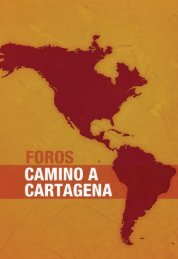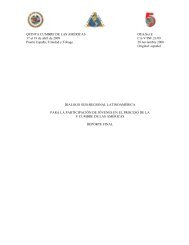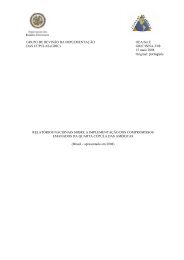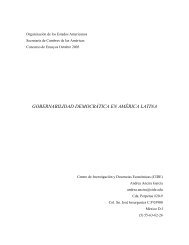The Road to Hemispheric Cooperation: Beyond the Cartagena
The Road to Hemispheric Cooperation: Beyond the Cartagena
The Road to Hemispheric Cooperation: Beyond the Cartagena
You also want an ePaper? Increase the reach of your titles
YUMPU automatically turns print PDFs into web optimized ePapers that Google loves.
include free trade agreements (FTAs), cus<strong>to</strong>ms unions<br />
(CUs), and common markets (CMs); and multilateral trade<br />
liberalization (WTO). With <strong>the</strong> Doha Round negotiations at<br />
a standstill, however, countries in <strong>the</strong> region have opted<br />
<strong>to</strong> place greater emphasis on regional and bilateral trade<br />
agreements. Within Latin America and <strong>the</strong> Caribbean (LAC),<br />
leaders in Mexico and Chile, and more recently Peru, have<br />
been spearheading free trade agreement expansion in <strong>the</strong><br />
region. For <strong>the</strong>se countries, <strong>the</strong> bulk of trade is regulated<br />
by such agreements: a full 87 percent of Chile’s <strong>to</strong>tal trade<br />
during 2010 was with trade agreement partners (both intraand<br />
extra-regional); for Mexico, <strong>the</strong> figure is 79 percent. 1<br />
<strong>The</strong> drift <strong>to</strong>ward regional trade agreements and preferential<br />
trade agreements (PTAs) contrasts with <strong>the</strong> sentiment<br />
and momentum of just two decades ago. In 1990, President<br />
George H. W. Bush floated <strong>the</strong> idea of a free trade area that<br />
would stretch “from Alaska <strong>to</strong> Tierra del Fuego,” which was<br />
later outlined under <strong>the</strong> vision of <strong>the</strong> Free Trade Area of<br />
<strong>the</strong> Americas (FTAA). In 1994, <strong>the</strong> United States, Canada<br />
and 32 LAC2 countries hoped <strong>to</strong> negotiate an all-embracing<br />
FTAA by 2005.<br />
Fast-forward <strong>to</strong> <strong>the</strong> present: <strong>the</strong> mood has changed. <strong>The</strong><br />
United States appears less enthusiastic about trade agreements,<br />
although recent FTAs with Colombia and Panama<br />
are important steps <strong>to</strong>ward fur<strong>the</strong>r integration with LAC<br />
countries. Mercosur gave priority <strong>to</strong> multilateral liberalization<br />
under Doha. Meanwhile, some governments in Latin<br />
America, pressured by public backlash against globalization,<br />
are turning <strong>the</strong>ir backs on open trade policies.<br />
However, <strong>the</strong>re are new potential success s<strong>to</strong>ries as well.<br />
In 2007, 11 countries on <strong>the</strong> Pacific side of <strong>the</strong> Americas<br />
formed <strong>the</strong> Pacific Basin Forum (in Spanish, ARCO) and are<br />
working <strong>to</strong> unify <strong>the</strong>ir trade agreements. A smaller grouping<br />
(Mexico, Colombia, Chile and Peru), under <strong>the</strong> name of Pacific<br />
Alliance, is trying <strong>to</strong> accelerate this process of convergence<br />
among <strong>the</strong>mselves (with recent interest from Costa<br />
Rica and Panama) <strong>to</strong> create seamless accumulation of production,<br />
which would allow countries <strong>to</strong> import intermediate<br />
goods from within <strong>the</strong> bloc and still satisfy rules of origin<br />
requirements. <strong>The</strong> Pacific Alliance, formally established in<br />
a Presidential Summit in 2012, will go beyond traditional<br />
trade in goods, exploring financial integration mechanisms,<br />
labor mobility, trade facilitation and cus<strong>to</strong>ms cooperation,<br />
among o<strong>the</strong>rs. Both Mexico and Central America are also<br />
requesting accumulation of origin in <strong>the</strong>ir agreements with<br />
<strong>the</strong> European Union. This would promote closer business<br />
linkages between Mexico and Central America by allowing<br />
cross-border production without violating rules of origin, and<br />
would help those countries capitalize on European markets.<br />
Fur<strong>the</strong>r, U.S. President Barack Obama recently unveiled<br />
initiatives <strong>to</strong> enhance regional integration in areas such as<br />
education exchanges, support for small and medium enterprises<br />
(SMEs), and broadband connectivity at <strong>the</strong> Sixth<br />
Summit of Americas, held in Colombia in April 2012.<br />
<strong>The</strong> global financial crisis of 2008-2009 presented ano<strong>the</strong>r<br />
potential turning point in trade policy in Latin America. While<br />
<strong>the</strong> region wea<strong>the</strong>red <strong>the</strong> crisis relatively well, average annual<br />
growth rates in LAC are still projected <strong>to</strong> have slowed<br />
<strong>to</strong> 3.2 percent for <strong>the</strong> period 2009-2013, compared with <strong>the</strong><br />
annual average of nearly 6 percent during <strong>the</strong> 2003-2007<br />
period. Europe, one of LAC’s major traditional trading partners,<br />
faces a period of prolonged economic stagnation. Just<br />
as <strong>the</strong> 1929 crisis led <strong>to</strong> more activist states in <strong>the</strong> region,<br />
and <strong>the</strong> 1982 debt crisis triggered wider-scale adoption of<br />
<strong>the</strong> Washing<strong>to</strong>n Consensus, 3 <strong>the</strong> ongoing global downturn<br />
will likely lead <strong>to</strong> rethinking <strong>the</strong> models of economic development<br />
and global engagement.<br />
This paper focuses on <strong>the</strong> shift <strong>to</strong>ward new regionalism<br />
in <strong>the</strong> Americas. By first contrasting “old” and “new” regionalism,<br />
this paper will <strong>the</strong>n consider <strong>the</strong> evolution of<br />
regionalism in LAC and <strong>the</strong> challenges of recalibrating<br />
hemispheric integration.<br />
Trends in Economic Integration in latin America and<br />
<strong>the</strong> Caribbean<br />
Latin America and <strong>the</strong> Caribbean (LAC) encompass diverse<br />
countries in terms of population, economic size,<br />
geography, stage of development, and linguistic roots, as<br />
well as ethnic and cultural backgrounds. In 2010, <strong>the</strong> LAC<br />
region accounted for about 8 percent of world population,<br />
and contributed about 7 percent of world GDP. When <strong>the</strong><br />
United States and Canada are included, <strong>the</strong> hemispheric<br />
share of <strong>the</strong> world economy rises above 35 percent.<br />
Currently, Latin America is well integrated in<strong>to</strong> <strong>the</strong> international<br />
trading system—a significant shift from <strong>the</strong> past.<br />
Latin America and <strong>the</strong> Caribbean accounted for 6 percent<br />
<strong>The</strong> <strong>Road</strong> <strong>to</strong> <strong>Hemispheric</strong> <strong>Cooperation</strong>: <strong>Beyond</strong> <strong>the</strong> <strong>Cartagena</strong> Summit of <strong>the</strong> Americas<br />
<strong>The</strong> Brookings Institution ❘ Latin America Initiative<br />
23








